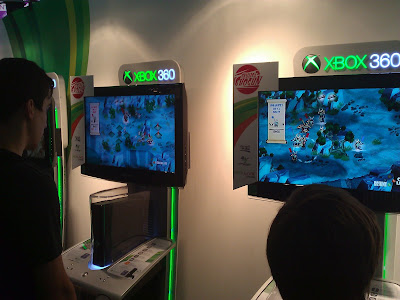I sent Borut my questions over email, and he answered me back! This is a photo of Borut.

George: When you first started programming did you pick it up right away or did you have trouble with it?
Borut: Well, I started programming quite a while ago, when I was about your age. Only the games you could easily learn to program were all text - I would copy a program that was printed out in a magazine or a book, enter it all in by typing it myself (since this was before the internet). So since the games were usually simple text-choice games, they were quick enough to learn for me then. As I got into more complex games, and graphics, it wasn't always that straightforward. I think learning's always tough but when you really like what you're learning you just don't notice all the effort you put in.
George: It takes me about one week to make my games. How much time does it take for you to make one?
Borut: Well, usually a bit longer. The one I'm mainly working on now has taken about 2 years (and will probably be done in six months or so). That can be tough to really stay disciplined to finish it over that long a period time. I do sometimes take a break from that to make a game in a few days - there's nothing quite as exciting as forcing yourself into doing something creative in a short time! :)
George: How do you design your characters?
Borut: Well, my teammate, Jake, he designs how the characters look. He uses a range of influences in his inspiration, like various artists from the past century (he studied art in school). He combines those inspirations in different ways to try and find something that conveys the personality and tone - for our game Skulls of the Shogun, the game is about ghost samurai, but it's humorous too, so the characters are meant to be spooky and a little goofy at the same time.
Then we have to design what the characters actually do - this affects how they look though, so as we change what they do we might update how they look. We use ideas from everybody (we have one other main teamember besides Jake & I, Ben), and then I try to make sure their actions all work together so the player has fun while using them. It always takes a lot of trial and error though, and learning along the way.

George: How do you get your games to look 3D?
Borut: We use all 2D art, but in code we draw everything in order from the top to the bottom of the screen - that way, when a character walks above a rock, the rock will get drawn above their bottom half, making it look they walked behind it. In order for that to work, we just have to make the collision around the rock lower than the image of the rock itself. Then we also add more layers of more 2D art on top of that, like clouds or rain.
George: How do you make your characters look different when they run and jump?
Borut: I wrote a custom tool to help animate our characters. With it, we can assemble a character from a bunch of different images, and then link them together. Then Jake creates animations, like running or jumping. He places the character pieces in one pose, then defines the pose for the character a fraction of second later, and keeps doing that until the end of one loop of the character running. Then the game takes those poses and repeats them as the character runs in the game.
This process ends up being pretty quick, so Jake can use the principles of good animation (which Disney originally pioneered -http://en.wikipedia.org/wiki/12_basic_principles_of_animation) to make characters seem like they have weight - heavy characters move slower, light characters move faster.
George: I see your games are about fighting. How do you make a lesson in them? I might want to try that.
Borut: Great question! That's something that actually is important to me too - Not all of the games I work on are about fighting, I've been working on another game that's about two parents who lose their daughter and have to look for her.
While a lot of games you see in stores are about fighting, games can really be about anything so I encourage you to experiment with making games with a moral or lesson.
In a book you can tell a story about a person who does something good and gets rewarded, or does something bad and gets punished, and that tells people a lesson. Games are about choice, though, so yo have to give players both good and bad choices at the same time. Then, when they choose the bad choices, make it harder for them to suceed at the game. Or if they make good choices, make it easier or more fun. The interesting thing about teaching a lesson in a game versus a story is that when people choose the right choice themselves in the game, it's a little like they did it themselves for real.
George: How do you get your games sold by companies?

Borut: That's changing - you used to have to talk to big companies like Microsoft, and get them to sell your game for you. These days, with the internet, you just sell your game on your own website too (like the game Minecraft). But if you want to put your game on any special hardware like the xbox or an iphone, you usually still have to go through the company that makes it (or another one that works with them), and get their approval. Some companies, like Apple or Microsoft with its Xbox Live Indie Games program, let you make a game, then just submit it and they'll approve it (as long as it works ok). then it'll be available for everybody to purchase.
George: When you first started programming, did you use Gamemaker? If you did, did you have to teach yourself?
Borut: When I started, and I programmed in a simple version of BASIC (the language of Visual Basic is based on that, but it's a much more advanced today than what I used back then). It was similar to scripting languages in tools like Gamemaker, though. I taught myself for a while, until our computer broke and it was several years until we got another one. Then I started programming again, and in high school I took the one class on computer programming we had. Then I went to college, where I studied computer science, which was the closest and most applicable thing I could study to making games. Today colleges & universities have all sorts of different programs you can study to work on games. There's also a lot of things beyond programming that are useful to know when making games, like math, science, art, even literature.
George: Do you know any other software I can make games on?
Borut: Flash has a lot of tutorials out there, and existing examples you can build on. Unity is a 3D game development tool - 3D may be more complicated & take more time to make games with, but you might want to try playing with that too in case you like it. There's also RPG Maker, which is good for making story-driven style games.
You can also try directly programming games, although it is harder. You can use a language like C#, and a tool called XNA, take an existing game, figure out how it works, then make a few changes to start & figure out the programming.
George: Borut gave me a lot of good information! If you have read my other blogs, you might have noticed that when he talked about the animation it was like my spider animation! Although the animations are similar, they are also very different. I really want to get Minecraft, so I was surprised he referenced it -- I didn't even tell him I want it! I wonder what the game where the mother and father lose the child is like? Just like the spider animation and his description is similar, making characters big and heavy and slow is just like my squid! Since he could make you lose the game in one hit, I made him very slow, just to make the game fair.
Thank you Borut!!
No comments:
Post a Comment